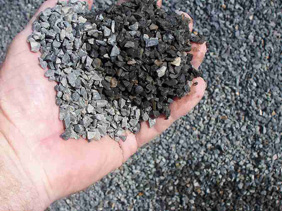
When you select the proper binder and aggregate, and compact it properly, it will produce a life-long pavement, says Wayne Jones, Asphalt Institute Senior Regional Engineer, at his presentation on materials selection at this year’s National Pavement Exposition in Nashville.
Remember, says Jones, hot mix asphalt is simply a combination of asphalt, aggregate and air (A+A+A = HMA.) Aggregate, which acts as the skeleton, provides skid resistance, stability and workability. The asphalt binder, which is the glue that binds the aggregate, provides waterproofing, flexibility and durability.
Aggregate is primarily responsible for the load-supporting capacity of a pavement. Aggregate types are natural or uncrushed (smooth and round)—or crushed with single or multiple crushed faces. Rough textured, crushed and angular aggregate is needed to carry heavy loads without rutting or deformation. Particle size and surface texture also change the workability, strength characteristics and compactability of an asphalt mix.
Maximum particle size and gradation are also key aggregate properties. Aggregate gradation is the distribution of the various particle sizes. The maximum particle size is important because it controls the appropriate lift thickness of the mixture placement. For good paving results, the lift thickness of a dense-graded asphalt mix should be 2½ to 3 times the maximum aggregate size or 3 to 4 times the nominal aggregate size in the mix.
A dense gradation of sound, tough, moisture-resistant aggregate contributes to pavement durability. It provides closer contact among aggregate particles, enhancing the impermeability of the mix. And a sound, tough aggregate structure resists deterioration under heavy traffic.
An aggregate’s strength or toughness is measured by its ability to resist wear and degradation. Aggregates at or near the pavement surface are subject to traffic abrasion and need to be tougher than aggregates in the lower layers. The Los Angeles Abrasion test (AASHTO T 96/ASTM C 131) has been the primary method to determine the wear or abrasion resistance of aggregate.
Superpave mixes
Superpave asphalt binders are called Performance Graded (PG) binders. They are graded according to the geographical areas where they are used. For example, in a PG 64-22, the “64” is the average 7-day maximum pavement temperature in celcius, to combat rutting during an extended summer heat wave. The “-22” is the minimum pavement temperature, again in celcius, chosen to withstand cracking overnight during the coldest night of a winter. On a typical mainline interstate pavement in a moderate climate, a PG 64-22 will accommodate trucks traveling at 70 miles per hour. But when the trucks start slowing, as when they are approaching toll booths, a PG 70-22 is needed to support the sustained pavement loading. At weigh stations, where heavy trucks come to a full stop, a PG 76-22 is required to support the pavement loads.
Standard Superpave aggregate sizes
Standard Superpave aggregate rock sizes range from 2 inches to minus #200 fines. Standard Superpave sieve sizes to measure aggregates range from 2 inch (50 mm) to #200 (.075 mm). Superpave base courses typically use 1.5-inch or 1-inch rock. Superpave surface courses typically use 3/8-inch rock.
Compaction
In the field, a mix that has 3 percent or less air voids may be susceptible to rutting and shoving. And mixes designed with more than 5 percent air voids are susceptible to raveling and oxidation. Field performance has shown that 4 percent air voids is an optimal design. It’s not too open and allows for a little extra compaction under traffic.
Mix design is important too. Designing the mix using a dense gradation with good aggregate interlock (stone-to-stone contact), maximizing the asphalt film thickness on the aggregate, and compacting the mix to proper air voids will prevent rutting or raveling.
Unacceptable materials
Acceptable and unacceptable materials depend on the type and purpose of the road or street. As the demands of traffic increase, the quality of the materials must increase. “A low-volume township road may be able to get by with lower quality local aggregates,” says Jones. “But a primary route demands higher quality materials that won’t fail under the extreme loads they are exposed to.” Thus, local materials are not acceptable for major highways or interstates. The traffic loads demand higher quality materials.
Quality control for traditional and new mixes
The appropriate quality control (QC) method for traditional and new materials is the same for both, says Jones. “A good QC operation actively monitors the aggregate source from stockpiling through production.” He adds that understanding how aggregates change over time and closely monitoring the mix is necessary for good quality control and to ensure the mix meets design parameters.
Key factors for selecting green materials
Hot mix asphalt is an environmentally friendly or “green” material because it is 100 percent recyclable. Selecting eco-friendly green materials such as Warm Mix, RAP or recycled asphalt shingles (RAS) require the same standards as apply to virgin mixes. “The key to success when adding RAP or RAS to the mix, is to be sure that the mix design meets the same requirements as does a 100 percent virgin mix,” says Jones. Whenever using coarse RAP, fine RAP or RAS, use the virgin mix design template.
Whether you are using green or traditional materials, says Jones, if you use the proper aggregate and asphalt binder, and compact the mix properly, you will produce a long-lasting pavement.
For more details about correct material selection see the AI publications:
MS-16 – Asphalt in Pavement Preservation and Maintenance
MS-4 – The Asphalt Handbook and
MS-2 – Mix Design Methods













